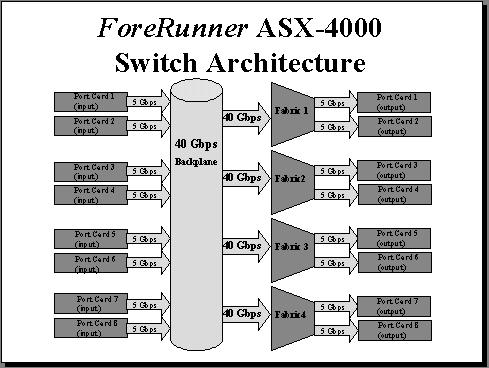
Vendors can exaggerate the switching capacity of their products in many ways. It can easily be over-stated by summing various inputs and outputs, or de-emphasized by including future capabilities that may, or may not, be delivered.
Rather than use the strict measure of full-duplex, non-blocking throughput, vendors often use a variety of techniques to 'calculate' switching capacity, making it appear to be more than it really is. These include:
The 'Duplex Double' Technique
Some vendors, especially those selling Gigabit Ethernet
and Layer 3 switches, double the stated throughput of their switches by
counting packets once on the way in and once on the way out. For example,
this makes a 25 Gbps switch look like a 50 Gbps switch. Using this technique,
the throughput of the ForeRunner ASX-4000 would be calculated as
80 Gbps.
The 'Port Arithmetic' Technique
Another questionable approach, often used by vendors
of service provider and enterprise WAN switches, is to multiply the total
number of ports by the individual port capacity. So, a 4-slot switch with
25-port 100BaseT cards is marketed as a 10 Gbps switch (25 ports x 4 slots
x 100 Mbps/port = 10 Gbps), even though the backplane has a capacity of
only 1.2 Gbps.
Of course, if the ports are full duplex, we can also apply the 'duplex double' technique as well, 'increasing' the capacity to 20 Gbps.
The 'Inside-the-Box' Technique
Commonly used by some vendors of enterprise and service
provider switches, this technique is similar to the 'port arithmetic' technique,
with a variation. A 15-slot switch with a 40 Gbps backplane/switching fabric
and single-port Gigabit Ethernet cards is marketed as a 40 Gbps switch—even
though maximum capacity is 15 Gbps (15 slots x 1 Gbps = 15 Gbps).
Another variation of this technique is to sum the various data flow speeds inside the box, exceeding true non-blocking performance. By applying this technique, the ForeRunner ASX-4000 would be marketed as a 200 Gbps switch.
The 'Future-Capacity' Technique
In this technique, for example, a switch with a capacity
of 15 Gbps is marketed with a capacity of 45 Gbps. Achieving the 45 Gbps
capacity, however, requires a future upgrade. The ForeRunner ASX-4000
supports 10-40 Gbps at first release.
The 'Rodeo' Technique
Some vendors of service provider switches 'tie-up' (or
interconnect) separate boxes, manage them as a single device, multiply
the capacity of each box by the number of boxes and, the next thing you
know, you have a '100 Gbps' switch. But is that really non-blocking? If
four ForeRunner ASX-4000 switches were combined and managed as a
single device, it would be considered a 160 Gbps switch.
What is the real capacity of the ForeRunner ASX-4000? At FORE, we prefer solving problems to creating hype. When we say the ForeRunner ASX-4000 is a 40 Gbps switch, we measure the full-duplex, non-blocking throughput.
The diagram below shows how the ForeRunner ASX-4000 supports up to 40 Gbps of input traffic sent to the passive backplane. Up to four switching fabrics each receive 40 Gbps of traffic from the backplane and switch it to egress (output) ports. So, you really get 40 Gbps of full-duplex, non-blocking switching from the ForeRunner ASX-4000.

Figure 1. The ForeRunner ASX-4000 supports up to 40 Gbps of input traffic sent to the passive backplane. Up to four switching fabrics each receive 40 Gbps of traffic from the backplane and switch it to egress (output) ports. So, you get 40 Gbps of full-duplex, non-blocking switching capacity.